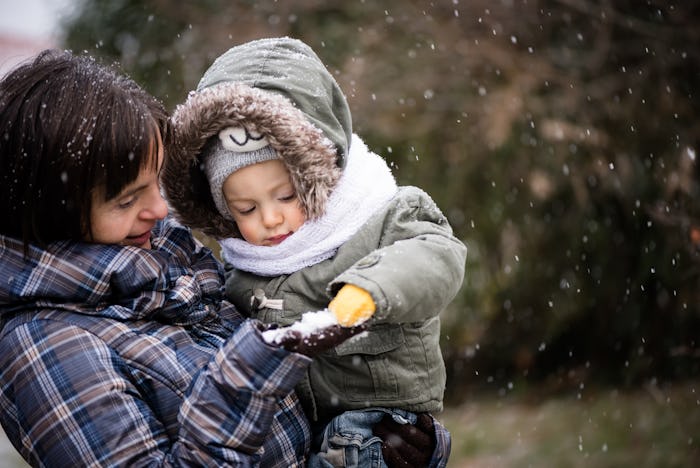Health

Here's Why Your Baby's Hands Get So Cold, According To Pediatricians
Plus, how to keep those frosty fingers warm and toasty.
Whether your child's little icicle fingers grab you while they're giving you a hug or you feel their chilly palm land on your chest as you nurse, you may be wondering, why does my baby have cold hands?
In most cases, these frigid little mitts aren’t something to be too concerned about. “It’s so normal for a baby’s hands and feet to be cold,” Dr. Randy Thornton, pediatrician at Wolfson Children’s Hospital tells Romper. He adds that “vascularization” is developing, and “the way the blood vessels are constricting and reacting is just not as efficient in a baby as they are as you get older.” Precisely because they're still developing, Dr. Thornton says that it's important to cover your baby's head on chilly days. "Children actually lose a lot of heat through their head. [Adults] heads are about an eighth of our entire body size. Their head is 25% to 30%. You can lose a lot of heat through there."
On a cold winter day or inside when the heat isn’t flowing, your baby’s hands may also be chilly for the same reason yours are. “Babies, like the rest of us, try to keep the insides of their bodies, the ‘core,’ warm when they get cold by decreasing blood flow to the extremities, especially the hands and feet,” pediatrician and American Academy of Pediatrics spokesperson, Dr. David Hill, tells Romper.
While cold hands and feet in babies and toddlers may be pretty harmless, you'll still probably want to keep your little one as comfy as possible by warming up their hands. "Babies can absolutely wear gloves or mittens when the weather calls for it," Dr. Hill tells Romper. "Many people cover newborns’ fingers with fold-over sleeves to prevent scratching, but some experts feel that this practice prevents them from using their hands to self-soothe or demonstrate hunger cues, so not everyone is a fan. The best practice is to keep the room a comfortable temperature and use a safe sleeper, like a sleep sack." Both Dr. Hill and Dr. Thornton say to avoid blankets and other forms of soft bedding in the first year of life to prevent SIDS, and flannel onesies or cozy sleep sacks are good for the nighttime. You could try gently blowing on their hands too, if you're out and forgot the mittens (it happens).
The flipside, as Dr. Thornton explains, is that you don't want to actually dress your baby too warmly. "You don't want to over-bundle a child. Some parents think they're cold and they overwrap them. If you see your child starting to sweat, they're probably over-bundled and can get overheated and even dehydrated." He adds that if the baby doesn't have a fever and seems to be behaving normally, cold hands are rarely something to worry about. So when are cold hands worrisome? "Very rarely cold hands might indicate a problem with the circulation like congenital heart disease or heart failure. They may also indicate anemia, especially if your baby also looks pale," Dr. Hill says. If your child's hands don't seem to warm up when they're in a warm environment or you're noticing other signs of anemia (fatigue, dizziness, weakness) check in with their pediatrician.
You might feel a little freaked out if your newborn has bluish or purple hands and feet, but Dr. Thornton assures parents that's actually very normal, too. "When they're first born the hands and the feet both [might] be a little bluish color," he says. "We call that 'acrocyanosis' and it's very normal. In the first two or three weeks, you'll see the pink come out. The worry parents have is [if their] child is getting enough oxygen. I always say, 'look at the lips'. If the lips are pink, you're fine but if the lips are blue, we [might have] a problem.
Rest assured that even when your child's frigid hands startle you, it's probably not big deal. And remember to stock up on lots of mittens for the winter, because they're bound to drop at least one.
Experts:
David L. Hill, MD, American Academy of Pediatrics spokesperson and author of Co-Parenting Through Separation and Divorce
Dr. Randy Thornton, pediatrician at Wolfson Children’s Hospital
This article was originally published on